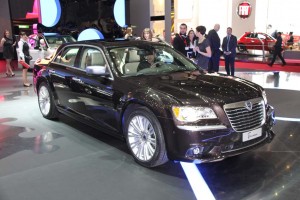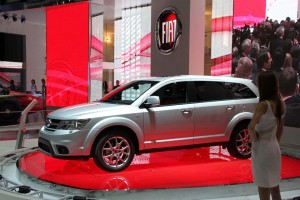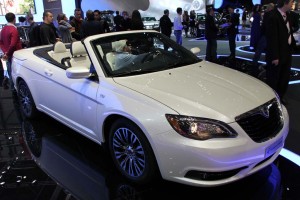If American visitors to the Geneva Motor Show get a sense of déjà vu at the Fiat and Lancia stands, that’s no surprise. While they might wear a European badge, a variety of new models are indeed familiar to U.S. motorists – and raise fundamental questions about the alliance between Fiat and its trans-Atlantic partner, Chrysler.
The most notable debut from Lancia at this year’s Geneva show is the Thema, a reborn version of the brand’s flagship, which was discontinued in 1994. While the badge on the grille might be Italian, the rest of the car is a virtually unchanged Chrysler 300, the new version of which has just launched in the U.S. market.
Think of it as, “The first global flagship that combines the best of two worlds,” Lancia officials declared during their press conference.
The Lancia stand also features the Voyager, also lifted, near whole, from the Chrysler line-up. And the maker is showing a new concept car, the Flavia, which is based on the U.S. 200 sedan. A production version is likely to debut in the coming months.
Over at the Fiat booth, the maker revealed the big Freemont crossover, also pulled from the Chrysler stable. The European version was “developed to meet European needs and expectations,” officials declared to the assembled press core.
But what that means is a matter of intense debate, especially among European media and potential buyers who have traditionally been wary of American automotive products.
With the Lancia Thema, the biggest change, other than the badging, can be found under the hood. Though the Chrysler 3.6-liter gasoline engine will be available to European buyers, about 80% of shoppers are expected to opt for a new 3.0-liter V6 turbodiesel – available in both 190 and 224-horsepower configurations.
Expect to see even more U.S. products under Italian badging. A Maserati sport-utility vehicle based on the Jeep Grand Cherokee is now in the works.
It’s a reversal of what happened two decades ago when Chrysler turned to the Italian luxury car maker for the Chrysler TC by Maserati. That model turned out to be a costly abortion, quickly dropped from the line-up. In that case, the project might have been described as the worst of both worlds, with a variety of quality problems and a design and execution that fell far short of what luxury buyers expected.
So why are the Italian and American marques setting out to try again?
For one thing, they can both use help expanding their line-ups but don’t have the cash to get where they need. That’s especially true for Chrysler, which was largely gutted by prior owners Daimler and Cerberus Capital Management, and which struggled through a 2009 bankruptcy. But even Fiat was struggling to get the models it needed before the tie-up with Chrysler as the U.S. maker emerged from bankruptcy.
By pairing platforms, the partners hope to maximize economies of scale, which can translate into substantial savings on every car and truck they produce. Sergio Marchionne, the CEO of both Fiat and Chrysler, has repeatedly suggested that a mainstream maker will no longer be able to remain competitive without pushing out at least 3 million vehicles annually. And he recently suggested “I might have to revise that figure” upwards to something like 5 million.
If the strategy works, Chrysler will benefit substantially, in the years ahead, as it begins rolling out new models of its own based on all-new or revised platforms it is developing with Fiat.
Some of the new products will be produced in Europe, at Fiat plants, but others, such as the upcoming Maserati sport-ute, will come from the States – in this case the long-underutilized Jeep assembly line in Detroit.
Exporting Chrysler-made products from the U.S. was one of three key targets set by the Obama Administration, following the Chrysler bankruptcy, by which Fiat could boost its stake in the American maker from 20% to 35%.
Another goal was building more fuel-efficient models in the States. Chrysler will achieve that using Fiat’s small engines and by the re-launch, after a two-decade absence, of Fiat’s U.S. dealer network. Its first product is the tiny 500 coupe.
But while the strategy may look good on paper, analysts question whether it can be pulled off effectively. The decision to simply switch badges on the new Fiat Freemont has had tongues clucking at the Geneva Show. “I don’t know how they can get away with that,” asserted a senior executive from a large European, who asked not to be identified by name criticizing a competitor.
The test will come when these “Lanchlers” and Chryliats hit market. If the new offerings fail to generate demand it could raise serious doubts about the long-term viability of the entire Fiat-Chrysler alliance.



